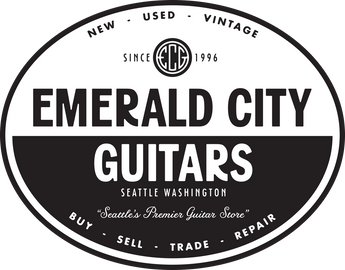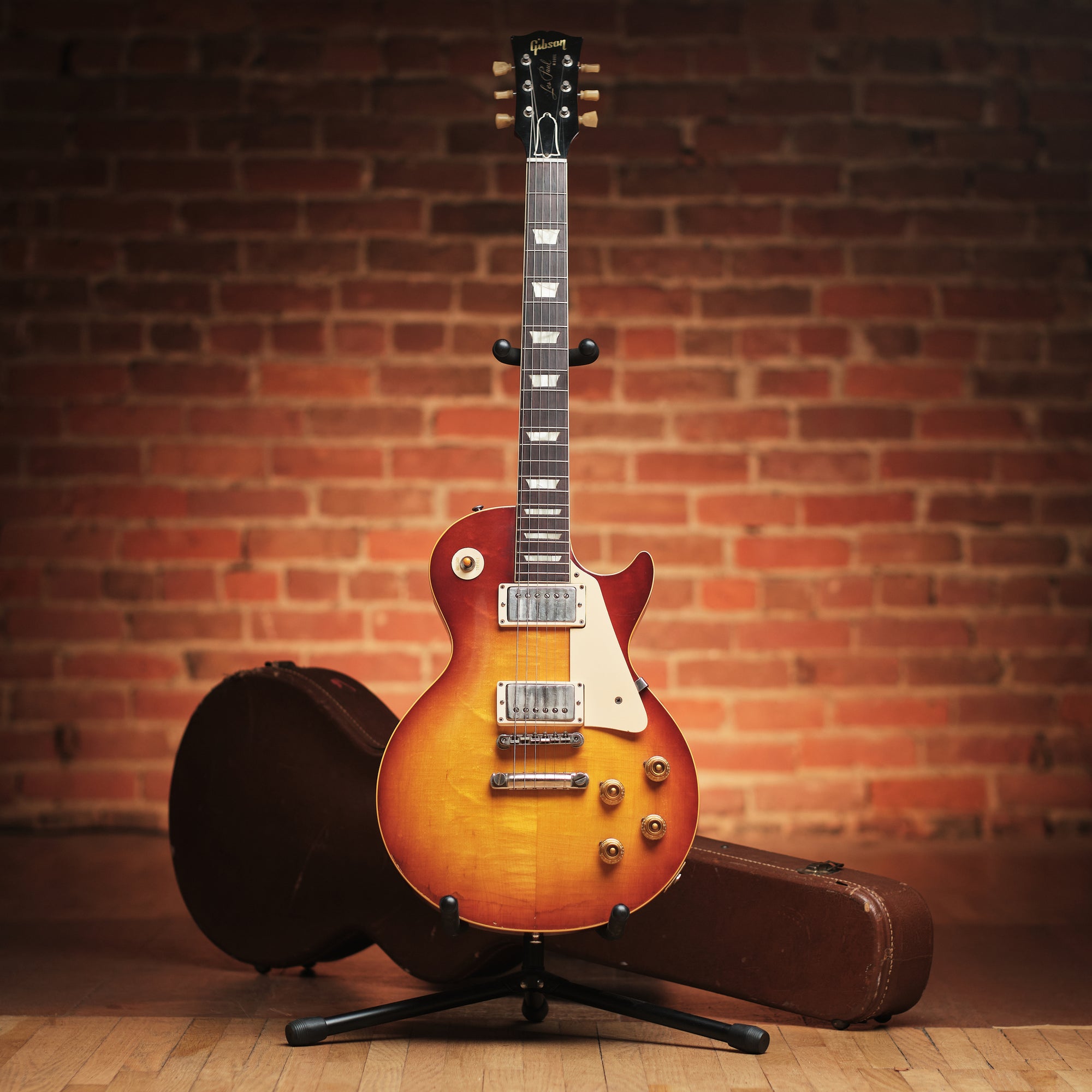1954 Fender Stratocaster
Seeing extremely early examples of iconic models always feels a little like peeking behind the wizard’s curtain. The ability to witness firsthand the vulnerabilities inherent in the early stages of creativity is a privilege, and fewer instruments offer us more insight than early Fender guitars.
Fender VP Forrest White insisted that all Stratocasters produced before October 13th, 1954 were either artist models, or what he called “pre-production samples.” That puts this August-made instrument well within the pre-production phase. As the name suggests, these instruments were either shipped to prominent musicians or sent to music stores to be used in demonstrations. It’s widely accepted that these early models were made mostly by hand, and accordingly, inconsistencies abound.
The headstock shape, contours, and neck transitions were obviously finished by hand and are utterly distinct to the assembly line models crafted just months later. The one-piece Ash body is feather light and beautifully figured, both unusual for the time. (The guitar weighs in at almost exactly 7 lbs) Cliches become cliches by being true, and such is the case when I say that no vintage guitar collection is truly complete without a 1954 Stratocaster. Pictured here with a matching 1955 Fender Tremolux from the same previous owner.
1956 Fender Stratocaster - Factory Black


The black Fender Stratocaster is about as ubiquitous as it gets. It’s safe to say that literally millions of them have been made, copied, reissued, and faked over the last 70 years. For this reason, it’s particularly exciting for us to be able to say with some certainty that this guitar was the 3rd black Strat ever built. One black 1954 Strat was built and used in a famous Fender promotional photo, held by Bill Carson. One black 1955 Strat was custom ordered by the guitarist from Gene Vincent’s band The White Caps.
This guitar is dated 1-56, with the next known black Strat not coming around until 1957. As rarefied as the world of 50’s Fender custom colors can be, this truly sits a tier above. A “Blackie” earlier and more righteous than Clapton’s very own. Need a little provenance? Pick up a copy of Andre Duchossoirs’ iconic 1994 book “The Fender Stratocaster.” This guitar has its own full-page centerfold.
1955 Gibson Les Paul Goldtop & Gibson GA-79

I’ve always felt a little sorry for the folks who bought a Prius during their first year of production. Just a few more years of waiting for the technology to mature would have yielded much fewer headaches and a notably better product in nearly every respect.
Despite the relative simplicity, I find that new guitar models can also tend to suffer early growing pains. Anyone who has ever tried to palm mute a ’52 Les Paul could corroborate. By late ’55, however, the Les Paul had managed to work out a number of early quirks, comfortably settling into what many consider its ultimate form. The stop tailpiece and ABR-1 bridge are an industry standard configuration to this day.
The Gibson P90 is responsible for the greatest blues, jump blues, soul, and R&B guitar tone ever recorded. (Required listening: Sean Costello) The neck profile is everything you want from a 50’s LP. It’s pictured here with a Gibson GA-79 amp, formerly owned and used by Steely Dan’s Walter Becker.
2007 Fender EVH & Marshall Bluesbreaker Conversion


For the last several decades there has been one unalienable truth in the world of guitar modification: where a young Strat owner is given access to masking tape and a few rattle cans, an EVH Frankenstrat tribute will inevitably emerge.
Fortunately, in 2007 Fender went to extraordinary lengths to create a limited run of identical replicas far beyond what any of us kids could manage. Combining world-class craftsmanship of the Fender Custom Shop with the unfathomable resources of a multinational corporation meant that absolutely no expense was spared in pursuit of authenticity.
Using Eddie’s original guitar as an in-hand reference, legendary Master Builder Chip Ellis singlehandedly crafted this instrument from the ground up. (It’s well known that Eddie was not able to tell the difference between his own guitar and an early example from this run of 300, forcing him to mark the replica’s headstock with a Sharpie.) Given the time and money spent by Fender to ensure the accuracy of this limited run, I don’t see even a remote possibility that a truer copy will ever be created. Pictured here with a Marshall Bluesbreaker conversion.
1963 Fender Bass VI & 1966 Electric XII


It could be argued, at no fault of their own, that some Fenders are easy to love. The Strat, Tele, and P Bass are American sweethearts. The Jazzmaster, Mustang, and Jaguar are a half step back and gaining every day.
But what about the misfits? The oddballs? The models you won’t see hanging on the wall of a Hard Rock Cafe? If you can track them down, you might find yourself holding one of the last untapped sources of vintage Fender magic. These two prime examples, a mint condition ’63 Bass VI and ’66 Electric XII, come to you in matching factory Olympic White. (The Bass VI is a one-owner local instrument with all hang tags and case candy.)
The rarity of these models can be boiled down to two factors: a relatively niche target audience, and an ungodly MSRP at the time of their introduction. But don’t confuse rarity with underrepresentation. The Bass VI was a favorite of both George and Paul throughout their moderately successful records Abbey Road and The White Album. In the mood to hear some some Electric XII? Look no further than the studio version of Stairway to Heaven. Pictured here with a beautifully worn 1962 Fender Princeton Amp.




